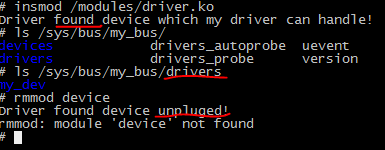Linux设备驱动工程师之路——设备模型(下)上层模型
Linux设备驱动工程师之路——设备模型(下)上层模型
K-Style
转载请注明来自于衡阳师范学院08电2 Y-Kee http://blog.csdn.net/ayangke,QQ:843308498
一、重要知识点:
设备模型由总线、设备、驱动三要素组成。
底层模型决定上层模型,在总线,设备,驱动的结构体中你总是可以看到它们间接或者直接的包含了kobject结构或kset结构。
1.总线
总线是处理器和设备之间的通道,在设备模型中,所有设备都通过总线相连,甚至内部的虚拟“platform”总线。在linux设备模型中,总线由bus_type结构表示。定义在<linux/device>中。
总线描述
bus_type的bus_type_private成员
可以看出该结构体中包含了有device和dirver的kset对象。
总线的注册:
int bus_register(structbus_type *bus);
如果成功,新的总线将被添加到系统,在/sys/bus目录下可以看到。
我们在深入看这个函数
从这里
priv->subsys.kobj.kset = bus_kset;
priv->subsys.kobj.ktype = &bus_ktype;
可以看得出总线初始化了自己的kset对象。
总线的删除
void bus_unregister(struct bus_type *bus);
总线的match方法
int (*match)(struct device *dev, struct device_driver *drv);
当一个新设备或者驱动被添加到这个总线时,该方法被调用,用于判断指定的驱动程序是否能处理指定的设备。若可以,则返回非0值。下面的测试程序采用匹配设备的dev->bus_id字符串和驱动的drv->name字符串是否相同来判断驱动是否能处理该设备。
总线uevent方法
int (*uevent)(structdevice *dev, char **envp, int num_envp)
在为用户产生热插拔事件之前,这个方法允许总线添加环境变量。
总线属性由结构bus_attribute描述:
struct bus_attribute {
struct attribute attr;
ssize_t (*show)(struct bus_type *bus,char *buf);
ssize_t (*store)(struct bus_type *bus,const char *buf, size_t count);
};
BUS_ATTR(name,mode, show, store)
在编译时创建和初始化bus_attribute结构,它将bus_attr_作为给定前缀来创建总线的真正名称。
如:static BUS_ATTR(version, S_IRUGO, show_bus_version, NULL);
将创建一个bus_attr_version结构体对象。
int bus_create_file(struct bus_type *bus, struct bus_attribute *attr)
创建属性文件
void bus_remove_file(struct bus_type *bus, struct bus_attribute *attr)
删除属性文件
2.设备
可以看出device结构体中也包含了一个kobject对象
intdevice_register(struct device *dev);
注册设备
vioddevice_unregister(struct device *dev)
注销设备
设备属性由struct device_attribute描述
structdevice_attribute {
struct attribute attr;
ssize_t (*show)(struct device *dev,struct device_attribute *attr,
char *buf);
ssize_t (*store)(struct device *dev,struct device_attribute *attr,
const char *buf, size_t count);
};
int device_create_file(struct device *dev, struct device_attibute *entry)
创建属性文件
void device_remove_file(struct device *dev, struct device_attibute *entry)
删除属性文件
3.驱动
驱动程序由struct device_driver描述:
在看device_dirver的driver_private 对象
struct driver_private {
struct kobject kobj;
struct klist klist_devices;
struct klist_node knode_bus;
struct module_kobject *mkobj;
struct device_driver *driver;
};
可以看出driver_private结构体中也包含了一个kobject对象。和连接设备的链表。
当总线的match返回非0值,也就是总线找到与驱动相匹配的设备时,驱动的probe的函数将被调用。
当设备从系统总删除是remove被调用。
当系统关机的时候shutdown被调用。
int driver_register(structdevice_driver *drv)
在总线上注册驱动
void driver_unregister(struct device_driver *drv)
载总线上注销驱动
驱动的属性使用structdriver_attribute来描述
structdriver_attribute{
structattribue attr;
ssize_t(*show)(struct device_driver *drv, const char *buf);
ssize_t(*store)(struct device_driver *drv, const char *buf, size_t count);
}
int dirver_create_file(struct device_driver *drv, struct driver_attribute *attr);
创建属性文件
void driver_remove_file struct device_driver *drv, struct driver_attribute *attr);
删除属性文件
二、测试模块
1.BUS
创建一条名为my_bus_type的总线和一个名为my_bus的总线设备,注意总线也是一个设备,也需要注册。
测试结果:

2.DEVICE
注册一个bus_id即名字为my_dev的设备,该设备的bus成员指向上一步创建的my_bus_type总线,parent成员指向上一步创建的my_bus总线设备。
测试结果:

3.DRIVER
创建一个名为“bus_dev”的驱动,并将bus成员指向第一步创建的my_bus_type总线
测试结果:
